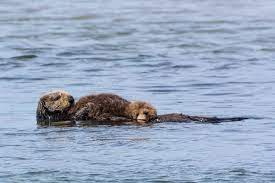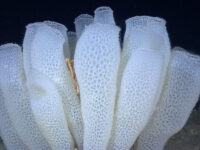Sea otters, adored for their expressive faces and fluffy fur, are some of the most well-known and charismatic aquatic animals. Beyond their cuteness, these marine mammals are keystone species that play an integral role in their environment. As top predators, sea otters are crucial to balancing coastal ecosystems such as kelp forests, enhancing ecological resilience to climate change. Recent research showcasing the sea otters’ environmental benefits may provide direction in the work to preserve these crucial ecosystems.
Found along rocky coastlines throughout the world, kelp forests are vast submarine habitats that support an extensive diversity of plants and animals. Kelp is a large, brown algae that thrives in cool, nutrient-rich, turbulent waters, forming dense stands similar to terrestrial forests. The kelp forest canopy offers abundant food and shelter for hundreds of species of fish, invertebrates, and marine mammals. Growing up to two feet per day under ideal conditions, this giant seaweed can extend to depths of 175 feet. Due to their quick growth rate, kelp forests are some of the world’s most productive ecosystems, rivaling tropical rainforests. Despite inhabiting a small percentage of the Earth’s total surface, kelp forests are estimated to capture 4.91 million tons of atmospheric carbon per year globally. Alongside carbon sequestration, kelp forests provide other valuable ecosystem services, such as reducing coastal erosion, promoting nutrient cycling, and supporting commercial fisheries, collectively generating an average of $500 billion annually.
Yet, kelp forests are declining across the globe due to several threats, including climate change, commercial overharvesting, and pollution. In addition to these anthropogenic stressors, overgrazing by predators contributes to the forests’ collapse. One such destructive grazer is the sea urchin; this spiky, spherical echinoderm has a voracious appetite for kelp. When its population grows without constraints, sea urchins can destroy entire stands of kelp, creating zones called urchin barrens. In these areas, sea urchins carpet the seafloor, turning the once vital and diverse kelp forest into a desolate region. The creation of urchin barrens marks a tipping point for the ecosystem in which essential functions are lost. Preventing this collapse is essential, which is why sea otters are integral components of kelp forests. Eating 25% of their body weight each day, sea otters keep sea urchin populations in check, guarding against overgrazing to maintain healthy kelp canopies rich in species. As a result, sea otters can nearly double the amount of carbon stored in a kelp forest.
“Eating 25% of their body weight each day, sea otters keep sea urchin populations in check, guarding against overgrazing to maintain healthy kelp canopies rich in species.”
In a recent study by Monterey Bay Aquarium, researchers found that California’s growing southern sea otter population increased kelp forest resiliency to environmental stressors and mitigated statewide decline over the last century. Using historical survey estimates and contemporary datasets of kelp forests, the researchers analyzed canopy coverage, biomass, and carbon storage from 1910 to 2016. Machine learning models indicated sea otter population density as the leading predictor of kelp canopy change during this period. Along California’s central coast — the only area where southern sea otters have recovered since being hunted to near extinction during the fur trade of the 1800s — the kelp canopy increased by 57%. This growth offsets the losses in regions where sea otters are absent. Although the canopy decreased along the northern and southern coasts by 63% and 52%, respectively, the overall decline across the entire state was only 6.9%.
While sea otters were the dominant driver of positive change in kelp forests, the study revealed other significant factors predicting decreases in the kelp canopy, including extreme marine heat. As climate change progresses, marine heat waves will increase in intensity and frequency, placing substantial stress on the sensitive kelp forest ecosystem. As sea otters buffer against heat-induced losses by maintaining ecosystem integrity, conserving this keystone species is essential to protecting kelp forests, including their rich biodiversity and instrumental ecological functions. Reintroducing southern sea otters to their historical ranges along the California coast offers a promising nature-based solution to promote kelp forest climate resiliency.






